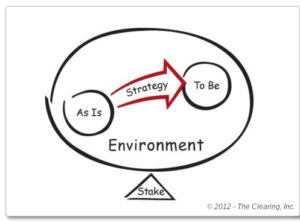Strategic planning is a fundamental necessity for sustained growth in both public and private institutions. But historically, it was a cyclical process. All too often, the process of strategic planning entailed a group of managers locking themselves in a room to draft a detailed and overly ambitious document that outlined a 5-10-year plan, which was then shelved to collect dust until it was time for the next strategic planning session. Unfortunately, the failure of many organizations to standardize the process of strategic planning while including a special focus on the viability of implementation and a continuous assessment of execution has created a stigma that devalues its true importance.
At The Clearing, we believe that strategic planning—when done properly—can make a substantial impact on your organization’s success. Our approach to strategic planning begins with a conversation about five essential agreements concerning the organization, the environment, and the future, all through the lens of “the voice of the customer.” These agreements are essential for the effective formulation of a viable and actionable strategic plan.
Recently I had the opportunity to outline The Clearing’s strategic planning process and demonstrate its value to distinguished partners of the American Council for Technology and Industry Advisory Council (ACT-IAC), a public-private partnership, while moderating a breakfast panel and training session at the headquarters of the National Aeronautics and Space Administration (NASA) in Washington, D.C.
Joined by esteemed panelists Dr. Michael New, Acting Deputy Associate Administrator for Research at NASA; Jeff Mohan, Senior Manager of Noblis; Tom Howder, Assistant Commissioner of GSA; and Maynard Crum, Senior Advisor of GSA, I walked the ACT-IAC partners through the five key agreements that comprise The Clearing’s strategic planning process and a practice strategic planning scenario.
Like most problem-solving techniques at The Clearing, our strategic planning process rests on the foundation of one of our proprietary frameworks called the PRIMES—in this case, the CORE PRIME. The CORE PRIME illuminates five essential agreements that planners must make and maintain to achieve extraordinary results. The PRIMES© are documented in the book, The PRIMES: How Any Group Can Solve Any Problem, (John Wiley & Sons, Inc., copyright © 2012) authored by Chris McGoff, founder of The Clearing. By coming to a consensus on these five agreements, planners can ensure high employee ownership in the vision and execution of the strategic plan. The five core agreements are:
1. As Is: People must agree on the current situation as it really is.
2. Environment: People must agree on what’s happening around them which they’re unable to affect, but which will affect them.
3. Stake: People must agree on what’s at stake if they stay where they are and don’t change.
4. To Be: People must agree on a cogent vision of the future they desire.
5. Strategy: Finally, people must agree on how to break out of the As Is and chart an irreversible course toward the To Be.

From these five agreements stem the questions that planners need to ask and answer to ensure a successful strategic planning session. These questions may seem elementary, but too often strategic planners skip these basic steps, resulting in lost time and opportunities in the long-run. Start slow to go fast, and begin with basic questions:
1. What is working well and what’s not working well? What is true today?
2. What’s going on in the outside world that impacts any future we choose to pursue? Where are we? Where are we going?
3. What is at stake if we continue as we are?
4. What is the future we want to create? What is the vision we’re most excited to create for our customers and for ourselves?
5. What are the critical few things we must focus on to achieve that vision?
By standardizing the strategic planning process and distilling the process to a science in this manner, leaders can ensure the development of a unified and visionary strategic plan for any organization. Once a plan is formed, leaders must constantly assess implementation, to flexibly manage any unexpected issues that may arise—and through this process, succeed.
To learn more about how The Clearing can support your organization in its strategic planning process, please reach out.
